Full setup guide of the salt spray testing chamber and its parameters required for test

Strong 8k brings an ultra-HD IPTV experience to your living room and your pocket.
Effective Lab India salt spray test chamber, also known as a salt fog chamber, is a device used to test the corrosion resistance of materials and coatings. It simulates a corrosive environment by generating a fine mist of salt water that settles on the test specimens. The primary users of such chambers are typically professionals in the fields of materials science, quality control, and product development.
Salt spray testing is an essential procedure in various industries, aimed at evaluating the corrosion resistance of materials and coatings. This method simulates harsh, corrosive environments to predict how materials will perform under prolonged exposure to salty conditions. Understanding which materials are used in salt spray testing and why they are selected is crucial for ensuring the reliability and durability of products.
Materials Used in Salt Spray Testing
Common Metals and Alloys
1. Steel
Steel, particularly carbon steel, is often subjected to salt spray testing due to its widespread use in construction, automotive, and manufacturing industries. The test helps in assessing the effectiveness of protective coatings such as galvanization, painting, or powder coating.
2. Stainless Steel
Stainless steel, known for its corrosion resistance, is another material frequently tested. Different grades of stainless steel (e.g., 304, 316) are evaluated to determine their resistance to chloride-induced corrosion, which is critical in marine environments.
3. Aluminum Alloys
Aluminum and its alloys are lightweight and commonly used in aerospace, automotive, and consumer electronics. Salt spray testing on aluminum helps in understanding the effectiveness of anodizing and other surface treatments.
4. Brass and Copper Alloys
Brass and copper alloys are tested primarily for applications in plumbing and electrical industries. The test assesses how these materials withstand corrosion when exposed to moisture and saline environments.
Protective Coatings and Treatments
1. Galvanized Coatings
Galvanization involves applying a protective zinc coating to steel or iron. This method is highly effective in preventing rust. Salt spray testing helps in evaluating the durability of galvanized coatings under aggressive conditions.
2. Anodized Coatings
Anodizing is an electrochemical process that enhances the natural oxide layer on aluminum. This coating provides excellent protection against corrosion. Salt spray testing ensures the integrity and longevity of anodized surfaces.
3. Powder Coatings
Powder coating is a dry finishing process that provides a robust and attractive finish. Salt spray testing is used to determine the resistance of powder-coated surfaces to corrosion and ensure their suitability for outdoor use.
4. Paints and Varnishes
Various paints and varnishes are applied to metals to prevent corrosion. Salt spray testing evaluates the performance of these coatings in protecting the underlying material from corrosion.
Factors Influencing Material Selection for Salt Spray Testing
1. Environmental Conditions
The choice of materials for salt spray testing often depends on the specific environmental conditions they will encounter. Materials used in marine environments, for instance, require higher resistance to salt-induced corrosion compared to those used in less aggressive environments.
2. Industry Standards and Requirements
Different industries have specific standards and requirements for corrosion resistance. For example, the automotive industry has stringent standards for materials used in vehicle bodies and components. Salt spray testing helps ensure compliance with these industry-specific standards.
3. Cost and Availability
The cost and availability of materials also play a significant role in their selection for salt spray testing. Commonly available and cost-effective materials such as carbon steel and aluminum are frequently tested to ensure they meet the required performance criteria.
Importance of Salt Spray Testing
1. Predicting Material Longevity: Salt spray testing provides valuable data on the expected longevity of materials and coatings.
2. Ensuring Product Reliability: For products that must withstand harsh environmental conditions, ensuring their reliability through salt spray testing is essential.
3. Enhancing Safety and Performance: In industries such as automotive, aerospace, and construction, the safety and performance of materials are paramount.
4. Meeting Regulatory Requirements: Many industries are subject to strict regulatory requirements regarding material performance and corrosion resistance.
What are the Parameters for Salt Spray Test?
The parameters for salt spray testing are critical to ensure accurate and consistent results. These parameters include:
Saline Solution Concentration: Typically, a 5% sodium chloride (NaCl) solution is used.
Temperature: The standard test temperature is 35°C (95°F).
pH Level: The pH of the saline solution should be between 6.5 and 7.2.
Spray Volume: The collection rate of the salt spray should be 1-2 mL per hour for a 80 cm² horizontal surface.
Test Duration: This can vary from a few hours to several thousand hours depending on the material and test requirements.
Angle of Specimen Placement: Typically, specimens are placed at a 15-30 degree angle from the vertical.
Chamber Humidity: The relative humidity inside the chamber is typically maintained between 95% and 100%.
What is the ASTM B117 Salt Spray Test?
The ASTM B117 salt spray test is a standardized test method established by the American Society for Testing and Materials (ASTM) for evaluating the corrosion resistance of materials and coatings. This test, also known as the salt fog test, is one of the most widely used accelerated corrosion tests globally. It involves exposing test specimens to a controlled corrosive environment, typically a salt fog or mist, generated from a saline solution (usually 5% sodium chloride) at a specified temperature (usually 35°C or 95°F).
What is SST in Coating?
Salt Spray Testing (SST) in coating is a widely used method to evaluate the corrosion resistance of various coatings applied to metals. It involves exposing coated specimens to a controlled corrosive environment, typically a salt fog or mist, to simulate real-world conditions. The test helps in assessing how well the coating protects the underlying metal from corrosion. SST is crucial for industries like automotive, aerospace, and construction, where coatings must ensure long-term durability and performance in harsh environments.
Can I Use Salt Spray Everyday?
Using salt spray everyday is generally not recommended, especially for hair and skin. While salt spray can add texture and volume to hair, frequent use can lead to dryness and damage due to the dehydrating effects of salt. For skin, daily exposure to salt spray can cause irritation and exacerbate dryness. It is best to use salt spray in moderation and follow up with moisturizing products to maintain the health of hair and skin.
Can we use salt spray test chamber at home?
Using a salt spray test chamber at home is generally not recommended for several reasons:
Size and Complexity: Salt spray test chambers are typically large and complex machines that require significant space and a proper setup. They are designed for professional use and may not be suitable for a home environment.
Cost: These chambers can be quite expensive, often costing thousands of dollars. This makes them impractical for personal use unless there is a specific need that justifies the investment.
Maintenance: Proper maintenance and calibration of the chamber are crucial for accurate results. This often requires specialized knowledge and equipment.
Safety: Handling salt solutions and operating the chamber involves certain safety risks, including exposure to corrosive substances and high-pressure systems. Proper ventilation and safety measures are essential, which are more easily managed in a professional setting.
Can a Salt Spray Chamber be Used by a Non-Technical Person?
While the operation of a salt spray chamber involves specific procedures and technical knowledge, it is possible for a non-technical person to use one with proper training and guidance. Here are a few key considerations:
Training: Adequate training is essential. A non-technical person should receive comprehensive instructions on how to operate the chamber, including safety protocols, setup, and maintenance.
Documentation: Clear and detailed user manuals should be provided. These manuals should include step-by-step instructions, troubleshooting tips, and safety warnings.
Supervision: Initially, it may be beneficial for a non-technical person to operate the chamber under the supervision of an experienced technician until they become proficient.
Automation: Modern salt spray chambers often come with automated features and user-friendly interfaces that simplify the operation. These features can make it easier for non-technical users to manage the testing process.
Conclusion
Salt spray testing is a vital process in assessing the corrosion resistance of materials and coatings. By understanding which materials are used in salt spray testing and why they are selected, manufacturers can ensure the durability, reliability, and safety of their products. This testing not only helps in predicting material longevity but also in meeting industry standards and regulatory requirements, ultimately contributing to the
Note: IndiBlogHub features both user-submitted and editorial content. We do not verify third-party contributions. Read our Disclaimer and Privacy Policyfor details.




